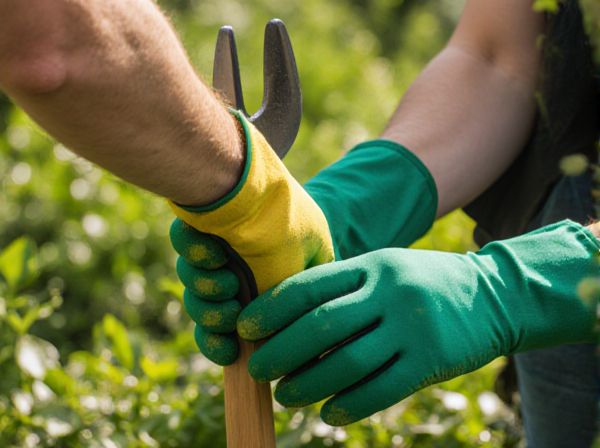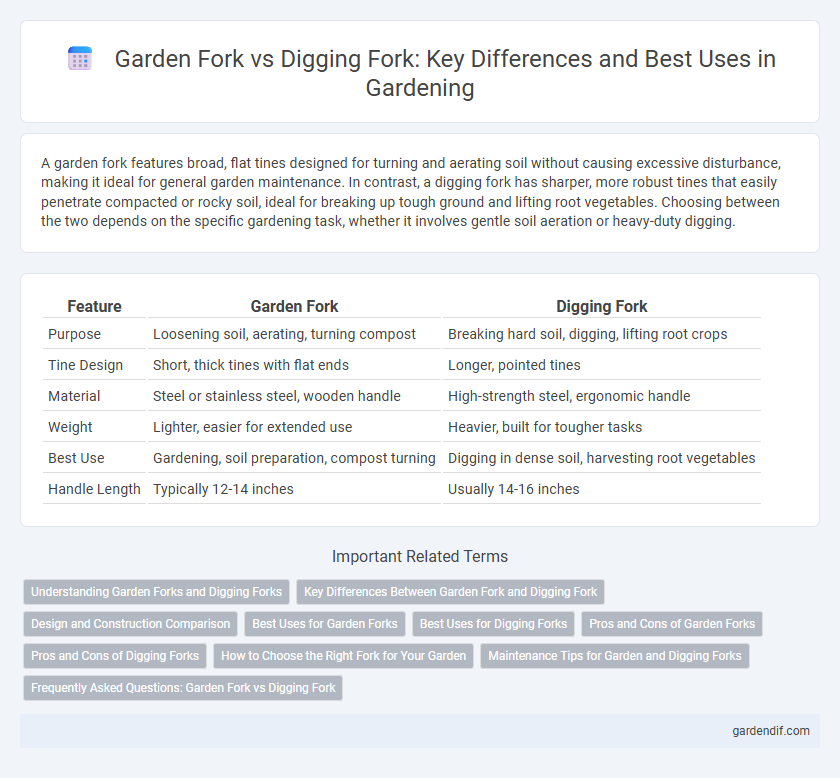
Garden fork vs digging fork Illustration
A garden fork features broad, flat tines designed for turning and aerating soil without causing excessive disturbance, making it ideal for general garden maintenance. In contrast, a digging fork has sharper, more robust tines that easily penetrate compacted or rocky soil, ideal for breaking up tough ground and lifting root vegetables. Choosing between the two depends on the specific gardening task, whether it involves gentle soil aeration or heavy-duty digging.
Table of Comparison
| Feature | Garden Fork | Digging Fork |
|---|---|---|
| Purpose | Loosening soil, aerating, turning compost | Breaking hard soil, digging, lifting root crops |
| Tine Design | Short, thick tines with flat ends | Longer, pointed tines |
| Material | Steel or stainless steel, wooden handle | High-strength steel, ergonomic handle |
| Weight | Lighter, easier for extended use | Heavier, built for tougher tasks |
| Best Use | Gardening, soil preparation, compost turning | Digging in dense soil, harvesting root vegetables |
| Handle Length | Typically 12-14 inches | Usually 14-16 inches |
Understanding Garden Forks and Digging Forks
Garden forks and digging forks are essential tools designed for different soil tasks; garden forks typically feature wider, flatter tines ideal for lifting and turning loose soil, compost, or mulch without damaging plant roots. In contrast, digging forks possess narrower, more robust tines suited for breaking up hard, compacted soil and penetrating clay or rocky ground. Selecting the appropriate fork depends on soil type and gardening needs, ensuring efficient cultivation and aeration.
Key Differences Between Garden Fork and Digging Fork
A garden fork features shorter, thicker tines designed for lifting and turning soil without breaking it up aggressively, making it ideal for aerating lawns and digging in compact soil. A digging fork has longer, sharper tines suited for breaking up dense, heavy soil and prying out roots or stones during deep digging tasks. Key differences include tine length, thickness, and intended soil penetration, influencing their effectiveness in specific gardening and landscaping applications.
Design and Construction Comparison
Garden forks feature shorter, thicker tines designed for prying and lifting soil with minimal disturbance, typically made from high-strength steel for durability. Digging forks possess longer, narrower tines that penetrate deeply to break up compacted earth, often reinforced with heat-treated steel to resist bending. Both tools incorporate ergonomic handles, but digging forks usually have a more robust construction to withstand heavy-duty excavation tasks.
Best Uses for Garden Forks
Garden forks are ideal for loosening soil, aerating garden beds, and lifting root vegetables with minimal damage. Their sturdy, wide tines penetrate tough, compacted ground more effectively than digging forks, making them perfect for preparing planting areas. Best used in general garden maintenance, garden forks excel at breaking up clumps and mixing compost into soil.
Best Uses for Digging Forks
Digging forks excel in breaking up heavy, compacted soil and lifting root vegetables without damaging them, making them ideal for garden beds and harvesting tasks. Their robust, closely spaced tines provide superior leverage for turning dense earth and removing deep-rooted plants. Garden forks, while versatile, are better suited for lighter tasks such as aerating soil and mixing compost rather than the heavy-duty use of digging forks.
Pros and Cons of Garden Forks
Garden forks offer superior soil aeration and ease of turning compost compared to digging forks, making them ideal for delicate root systems and lightweight tasks. However, garden forks typically have shorter tines and less heavy-duty construction, limiting their effectiveness in breaking hard, compacted soil or dealing with large roots. Their ergonomic design provides less strain during prolonged use, but they may not perform as well in tough, rocky garden beds where digging forks excel.
Pros and Cons of Digging Forks
Digging forks offer superior soil penetration and aeration, making them ideal for breaking tough ground and turning compost with minimal effort. Their sturdy tines provide excellent leverage for heavy-duty tasks but can be heavier and less maneuverable in tight spaces compared to garden forks. While digging forks excel in durability and strength, they may cause more soil disturbance, making them less suitable for delicate planting areas.
How to Choose the Right Fork for Your Garden
Choosing the right garden fork depends on the task: garden forks have longer, flatter tines ideal for turning and aerating soil, while digging forks feature shorter, stronger tines designed for breaking compacted earth and lifting root vegetables. Consider the size and soil type of your garden, as digging forks excel in heavy, clay soils and rocky conditions, whereas garden forks work best in lighter, well-tilled soils. Ergonomic grips and tine material, such as forged carbon steel for durability, also influence the efficiency and comfort of the fork during extended use.
Maintenance Tips for Garden and Digging Forks
Regular cleaning of garden forks and digging forks prevents soil buildup and rust, extending tool life. Sharpen the tines periodically with a file to maintain effective penetration and ease of use. Store forks in a dry place, preferably hanging or off the ground, to avoid moisture damage and preserve the integrity of wooden handles.
Frequently Asked Questions: Garden Fork vs Digging Fork
Garden forks feature broader, flatter tines ideal for turning loose soil and aerating garden beds, while digging forks have narrower, stronger tines designed for breaking hard ground and lifting dense materials. Users often ask which fork is best for compost turning or root harvesting, with garden forks excelling in light, aeration tasks and digging forks suited for heavy-duty digging. Selecting between the two depends on soil type and gardening needs, ensuring efficiency and tool longevity.
Garden fork vs digging fork Infographic

 gardendif.com
gardendif.com